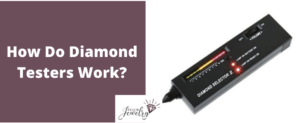
When you purchase a diamond, you need confidence to know you’re getting what you pay for. Unfortunately, the jewelry industry isn’t immune to fraud, and purchasing a diamond that turns out to be fake could be a decision that costs you thousands of dollars.
One way to avoid this mistake is with a quality diamond tester. In order to use it properly, it’s important to know the basics of diamond testers, how they work, if they are reliable, and what to consider when purchasing one.
What is a Diamond Tester?
A diamond tester is a small, portable device used to indicate whether a diamond is real. The design of these devices is simple, and they’re small enough to place in your pocket when shopping for jewelry.
Diamond testers feature a scale of one to eight, with a color-coding of green to red that indicates if the diamond is genuine. Along with the light indication, most have an audible alarm that increases in frequency when detecting a real diamond.
Diamond testers are used by both consumers and jewelry professionals around the world to quickly and easily test diamonds in a jewelry piece. Running off a nine-volt battery, a diamond tester is simple to operate and maintain and can be a cheap investment that saves you from spending money on a fraudulent diamond.
While many consumers are more trusting of high-end jewelry stores that have established brands, it’s essential to have it when shopping at independent stores or when buying jewelry secondhand.
How Diamond Testers Work
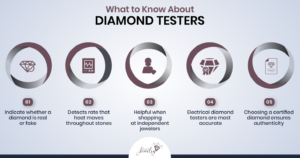
Diamond testers work by detecting the rate heat moves through the diamond or stone. Some use electrical conductivity to examine how electricity travels through the stone. These tests are very similar in design. One uses heat while the other uses electricity.
Heat and electricity flow differently through a diamond than they would flow through glass, cubic zirconia, or other materials used to make fake diamonds.
To use a diamond tester, press it against the diamond and wait for the reading. It’s a quick and easy way to ensure you’re getting a real diamond.
One exception to these diamond testers is they cannot detect lab-created diamonds. Since natural diamonds have the same chemical makeup as lab-grown diamonds, a diamond tester will not be able to detect them.
Are They Reliable?
When making a purchase as expensive as diamond jewelry, you have to ensure you’re paying for authenticity. Diamond jewelry can range from a few hundred to thousands of dollars, so it’s no surprise there are fake or counterfeit products being made every day.
Having a reliable diamond tester can be the difference between paying thousands of dollars for a fake diamond or investing in a quality piece of jewelry.
Diamond testers are one of the most accurate tools to determine whether a diamond is fake or real. They’re used by professional jewelers to test diamonds but aren’t too complicated for the average consumer to use.
One thing to take into consideration is many people use moissanite as a diamond, and it conducts heat very similar to a diamond. An electrical diamond tester will increase the chances you get accurate readings for every type of stone.
Heat vs. Electric Diamond Testers
There are two types of diamond testers popular on the market: electrical and heat. Both are effective, but each have pros and cons.
A heat diamond tester uses a heated tip that allows it to measure how well heat travels through the stone. It’s older technology compared to electrical diamond testers but is still considered reliable in the industry.
Electrical diamond testers are often better because they detect commonly used fake diamond materials.They can also be used to detect real gemstones because they share some of the same properties.
What to Look for in Buying a Diamond Tester
When buying a diamond tester, there are a few aspects to consider to ensure you choose a reliable one:
- Electrical conductivity
- Magnification
- Metal detection
- Usability
Let’s review these key features that will add value to a diamond tester.
Electrical Conductivity
An electrical conductivity diamond tester will give you the most accurate readings no matter what material makes up the stone. This is especially true for differentiating between moissanite, which heat diamond testers have a problem detecting.
Magnification
Some diamond testers come with a magnifier that lets you to examine the diamond more closely. This is less about determining if it’s real and more about identifying any blemishes or irregularities that may diminish its value.
These qualities could be inclusions on the inside of the diamond such as feathers or twinning wisps or scratches on its surface.
Metal Detection
Some diamond testers have a metal detecting feature that lets you know if you accidentally touch the metal part of the ring. When working with smaller diamonds and jewelry, it may be hard to stay right on the diamond.
Getting a false reading from the nearby metals could cause you to think it’s a real diamond. A diamond tester with metal detection sounds an alarm when you hit metal, preventing this common mistake.
Usability
There’s no sense in purchasing a diamond tester if it’s too complicated to use. There are options that range from user-friendly to incredibly complex, and you should choose one that fits your level of knowledge.
Those working in the jewelry industry have a lot riding on their ability to determine real from fake and thus should invest in one with the highest degree of accuracy across any type of stone. Consumers, on the other hand, may just need one to confirm a single diamond purchase.
Types of Diamond Testers
StillCool Diamond Tester II
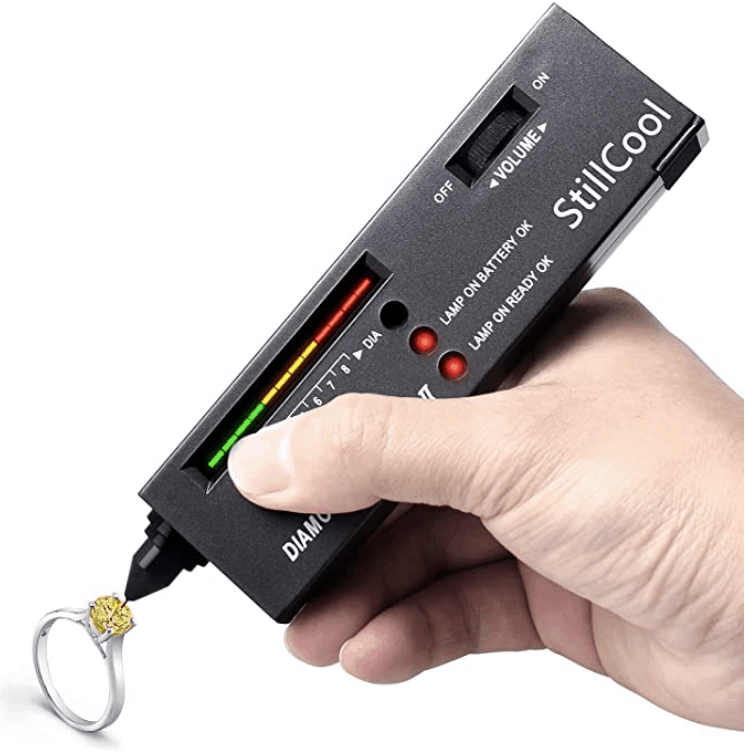
The StillCool Diamond Tester II is the perfect choice for the average consumer needing to know whether a diamond is real. It’s electric, portable and can quickly test whether a stone is a fake crystal or a simulant such as cubic zirconia.
It offers a metal alert, so you’ll know if you’re accidentally touching the metal shank as opposed to the stone.
HDE Jewelry Diamond Tester
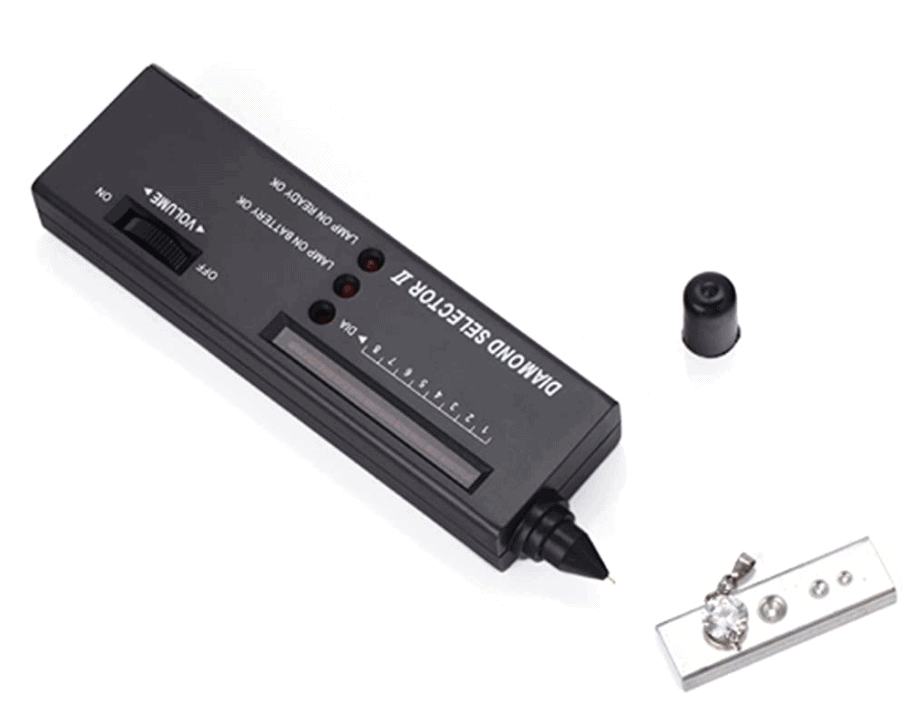
The HDE Jewelry Diamond Tester is another consumer-friendly diamond tester that also works on sapphires, emeralds, and rubies. It emits audible sounds that allow you easily differentiate when it’s detecting a real or fake diamond.
Whether it’s a diamond bracelet, ring, earrings, or necklace, you’ll be able to distinguish between a diamond and cubic zirconia or other fake stones.
GIA iD100
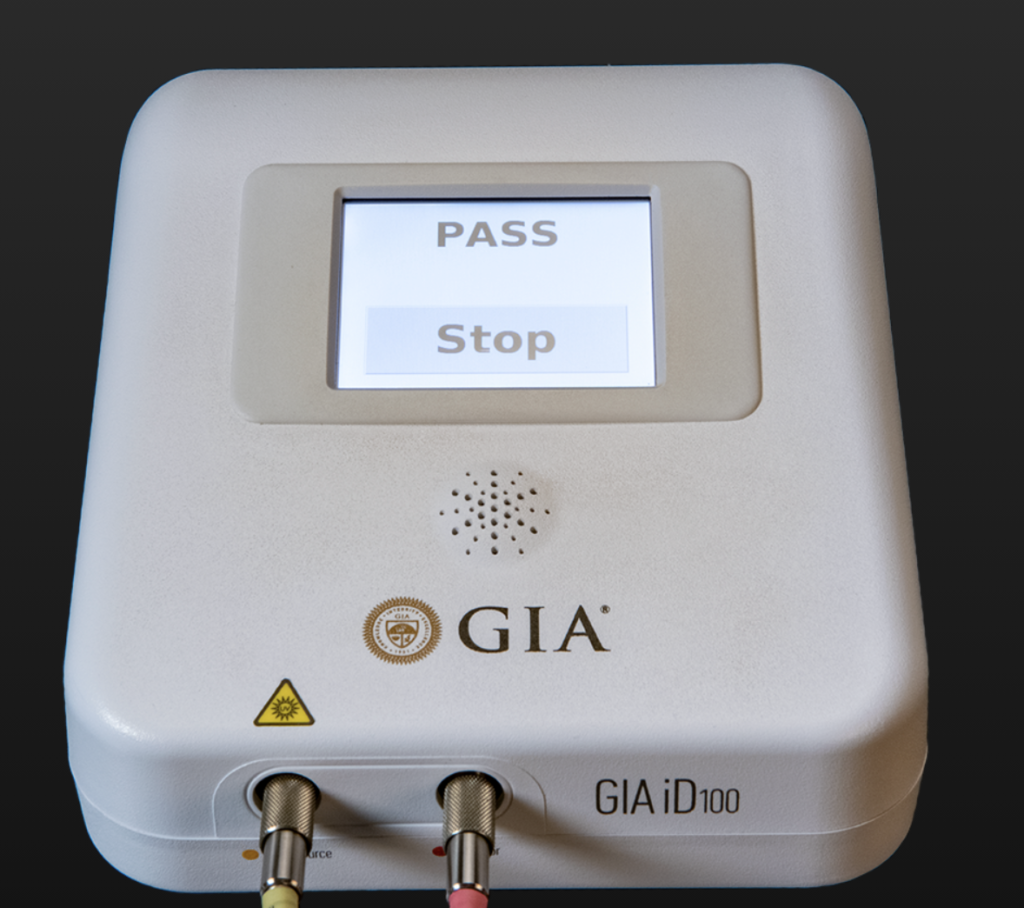
The Gemological Institute of America (GIA) is the premier organization for evaluating the quality of diamonds. Knowing many diamond testers cannot distinguish between lab-grown and natural diamonds, it developed the GIA iD100 to “detect trace amounts of lattice defects” in diamonds that proves its origin.
This high-end diamond tester isn’t for the average consumer. Instead, it’s only necessary for those who operate a jewelry business and know the success of their venture relies on the ability to distinguish between real and fake diamonds.
Conclusion
Diamonds are too expensive of a purchase to allow yourself to buy a fraudulent one. Diamond testers allow you to take the first step in determining its authenticity by first learning whether it’s a real diamond.
There are options on the market ranging from less than $20 up to thousands of dollars. While professional jewelers or diamond certifying institutions may want to invest in a machine that catches every type of fake diamond, the average consumer can generally get by with the more affordable options.
If you test a diamond and don’t have confidence in the result, it’s best to play it safe and not risk purchasing a fake diamond that won’t have any value to you or as a resale.

Jacob Clarke
Jacob Clarke is the founder of TeachJewelry.com.
He earned an Applied Jewelry Professional Diploma from the Gemological Institute of America (GIA) and now brings you essential information about diamonds, settings, and more.
Jacob has consulted with leading jewelry brands, and his work has been cited in Clean Origin, Diamond Nexus and industry publications.
He's also a member of the International Gem Society.
He enjoys discussing jewelry with readers, so contact him with any questions at jacob.clarke@teachjewelry.com.













